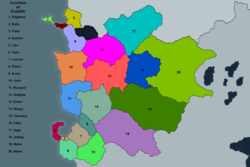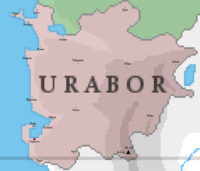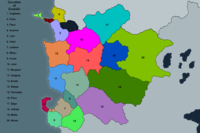Urabor
| The Kingdom of Urabor Qlau Hn Ürabȍȍr QLAU HN ÜRABȌȌR |
||||||
|---|---|---|---|---|---|---|
|
||||||
| Motto: "Ɉoləhan Gaǩarokava Ïluhäġaltr" ɈOLƏHAN GAǨAROKAVA ÏLUHÄĠALTR "God's mighty fist" |
||||||
| Anthem: "Ɉoləhan Gahont Sä Loǩarokava" ɈOLƏHAN GAHONT SÄ LOǨAROKAVA "Lord give her strength" |
||||||
Counties of Urabor
|
||||||
| Capital and largest city | Üdgänen | |||||
| Official languages | Aldahnten | |||||
| Recognised national languages | Kavrinian Setyalnian |
|||||
| Recognised regional languages | Nuhzäyin Münida |
|||||
| Ethnic groups | 61.5% Kav 30.7% Human 7.78% Fals 0.02% Dalar |
|||||
| Demonym | Ürabȍȍrħen ÜRABȌȌRĦEN Uraborian |
|||||
| Government | semi-constitutional monarchy | |||||
| - | Ɉal ɈAL Queen |
Bärmey Jäçar BÄRMEY JÄÇAR |
||||
| - | Ɉalħen ɈALĦEN Archduchess |
Daiġa Jäçar DAIĠA JÄÇAR |
||||
| Legislature | Klinɉalsheük KLINɈALSHEÜK |
|||||
| - | Upper house | Klinɉalsiðogd KLINɈALSIÐOGD |
||||
| - | Lower house | Mucithnsheük MUCITHNSHEÜK |
||||
| Establishment | ||||||
| - | The Orenahn tribes arrive at the Ðravəna bay and modern day Üdgänen, marking the start of the Orenahnian Cheifdoms and day of ancestors | ~ 2750 ǨÜ | ||||
| - | The War of Dominance and establishment of the Lömeqű empire along the coast of modern day Ürabȍȍr and the day of Prevailing | ~ 1370 ǨÜ | ||||
| - | The Ralmï coup and establishment of the Fascist state of Ralmïanï, marking the day of Judgment | 263 ǨÜ | ||||
| - | The War of Freedom and establishment of the Kav republic of Neshim, marking the day of Praise | 179 ǨÜ | ||||
| - | The War of Iindependence and establishment of the Kingdom of Ürabȍȍr, marking the day of Freedom | 0 KÜ | ||||
| - | The beginning of the Ɉolbaɉiġa genocide and marking the day of mourning | 773 KÜ | ||||
| - | Beginning of the Jäçar Dynasty, coronation of King Ġaɉar Üdgän Jäçar and marking the day of God | 1106 KÜ | ||||
| - | Unification into the Grand Alliance Confederation | 1636 KÜ | ||||
| - | Establishment of current borders of The Kingdom of Ürabȍȍr after the fall of the Setyal Empire and marking the day of Unification | 1751 KÜ | ||||
| Area | ||||||
| - | 397,638 km2 153,529 sq mi |
|||||
| Population | ||||||
| - | 2020 census | 35,507,857 | ||||
| - | Density | 34/km2 88.1/sq mi |
||||
| GDP (nominal) | estimate | |||||
| - | Total | $712.6 Billion | ||||
| - | Per capita | $17,246 | ||||
| Gini | 38 medium |
|||||
| HDI | 0.63 medium |
|||||
| Currency | Ȝülaħa (UYH) | |||||
| Time zone | (SCT-5) | |||||
| Date format | dd-mm-yyyy KÜ dd-mm-yyyy KĠ dd-mm-yyyy |
|||||
| Drives on the | right | |||||
| Calling code | +362 | |||||
| Internet TLD | .ur | |||||
Urabor (Aldahnten: QLAU HN ÜRABȌȌR Qlau Hn Ürabȍȍr [qlau hn ʏrabʊːr]), officially the The Kingdom Of Urabor, is a country located in western Upper Boroso. Urabor is bordered by Lhavres to the north and the Czucz sea to the west. Urabor is divided by population into 20 administrative counties. Geografically, Urabor has a mountainous interior and costal semi-arid deserts and a small savanah around the Ðravəna bay (Aldahnten: ÐRAVƏNA KȀLO Ðravəna Kȁlo [ðravʔna kælɔ]). Urabor is traditionally a matriarchal society, pushing its women to the forefront of all discussions and decisions.
Etymology
The name Ürabȍȍr (ÜRABȌȌR) is derived from the word Üra (ÜRA) [ʏra] meaning desert and the word Bȍȍr (BȌȌR) [bʊːr] meaning tribe, as the current Kingdom was established by the desert tribe lead by Naəv Tƿvanï (NAƏV TǷVANÏ) [naʔv twvani].
History
Geography
Geology
The Highest point in Urabor is Mt. Ɉol (Aldahnten: BAɈIĠA ɈOL Baiɉġa Ɉol [badʲɪɣa dʲɔl]) at 3,754 meters (12,316 feet).
Climate
The majority of Urabor is a Hot Semi-Arid desert whilst the counties of Flant and Neshim are classified as a Tropical Wet and Dry Savanah.
Biodiversity
Politics
Government
Urabor as it stands today is ruled under a semi-constitutional monarchy headed by The Queen and Oracle of Ɉolbaɉiġa Bärmey Karmen of the Jäçar clan and her Sister Archduchess and Speaker, Daiġa Þȁlǩov Jäçar. Who's family has been the monarchs since 1106 KÜ and subsequent establishment of the Jäçar dynasty by King Ġaɉar Üdgän Jäçar, great-great-grandson of the prophet Sðälṗ. And records official dates as such giving Urabor three different calendars. KÜ (KLVA ÜRABȌȌR Klva Ürabȍȍr [klva ʏrabʊːr]), KĠ (KLVA ĠAɈAR Klva Ġaɉar [klva ɣadʲar]) and standard. Being 1928 KÜ, 789 KĠ, and 2021 respectively, at time of writing.
Administrative divisions
Urabor is split into 20 Counties, each named after their respective capital. All counties are sized by their respective populations with larger populations being in smaller counties and smaller populations in larger counties to accommodate respective businesses and distribution of wealth
Foreign relations
Currently Urabor has trading realtions with Cananganam, trading Natron and Sand, for food products and manufacturered goods. In turn the propagation of Lunukisisu in the northern counties of Urabor has been slowly integrated into local traditions and religion of Ɉolbaɉiġa.Though Cananganam has had a presence within Urabor for centuries now, with its missions, only with the Establishment of the Jäçar dynasty in 1106 KÜ has Urabor recognized its state religion and the legitimacy of its missions within the Kingdom.
Military
Urabor requires a 6 year minimum military conscription beginning at age 20 for men and an 8 year minimum conscription beginning at age 18 for women. Any military service afterwards is paid and rewarded greatly.
Urabor holds a standing army of 1,500,000 at times of peace and increases its army to 5,000,000 at times of war. Any attempt to dodge conscription or draft, outside of medical reasons, is a punishable offense of at minimum 5 years in prison and a 150,000 Ȝülaħa fine.
Though Urabor is sympathetic to immigrants, and willing to accept them, any immigrants wanting citizenship under the age of 26 must enter military service for a minimum of 2 years. Whilst long-term non-citizen immigrants must enter military service for a minimum of 2 years, if they are under the age of 30. Whilst their children must enter military service for a minimum of 4 years at age 22 regardless of gender.
Military service in Urabor is seen as a great honor and is a prime reason a 6 year minimum service is a requirement for full citizenship, given the parents of said citizen are also full citizens.




